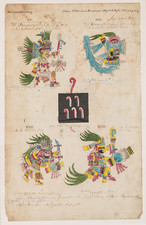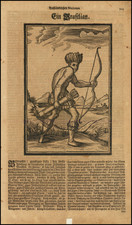In April 1833, explorers Prince Maximilian and Karl Bodmer crossed paths with a number of Sauk and Fox individuals during their expedition in St. Louis, Missouri. Among these individuals were Massika (Turtle) and Wakusásse, whose names have been recorded but with no translation provided for the latter.
Bodmer, a Swiss painter known for his detailed and evocative portrayals of Native American life, created two original field sketches (The Joslyn Museum's KBAS 132 and 133) during this encounter. These watercolor and pencil drawings closely align with the figures presented in his tableau. For instance, Wakusásse's necklace and robe, left incomplete in the original drawing, were likely filled in later, while Massika is depicted with a large roach (a traditional Native American hairpiece) with a single, horizontal feather.
It is interesting to note that Maximilian might have contributed to the detailing of the sketches. The Prince himself was known to have drawn examples of Sauk roaches and even a portrait of Massika in his journal. He was also meticulous in documenting the hues and textures of beads and feathers, providing Bodmer with additional details to enrich his drawings.
In the tableau's initial conception, Bodmer planned to pair a portrait of Massika with that of Watapinat, a Fox man. Unfortunately, the sketch of Watapinat was mysteriously lost at the engraver's, leading to a shift in the tableau's composition and a significant delay in its production. Bodmer, in a letter to Maximilian, proposed substituting Wakusásse for the lost portrait, noting that any personal recognition would be an innocuous mix-up of the names.
Maximilian's response to Bodmer's proposition remains unknown, but the fact that Wakusásse's name appears on the print suggests that Maximilian did not support the name change. Given the existing inscriptions on the plate, the engraver likely produced an entirely new plate. The lengthy period between the disappearance of Watapinat's portrait and the completion of the print adds weight to this theory.
This episode involving the creation of Bodmer's tableau underscores the creative process's complexities and contingencies, revealing a fascinating intersection of artistic expression, cultural representation, and historical documentation in the 19th century.
State
Ruud's first of two states.










![(Mexican-Aztec Painting) [Watercolor of three Aztec deities from the Codex Vaticanus:] Toxcatl, God of Droughts and Inundations. Cod. Vat. Tlaloc. God of Water. Cod. Vat. Tecuilvitontl [Tecuilhuitontli] The Lesser Festival of the Lords. Cod. Vat.](https://storage.googleapis.com/raremaps/img/small/103009.jpg)
![[Osage] Die Osagen-Indianer](https://storage.googleapis.com/raremaps/img/small/89381.jpg)

![[ Florida Indians - Preparations for a Feast ] Conviviorum apparatus](https://storage.googleapis.com/raremaps/img/small/98462.jpg)
![[ Florida Native Americans Declaring War ] Bellum denunciandi ratio. XXXIII.](https://storage.googleapis.com/raremaps/img/small/98006.jpg)